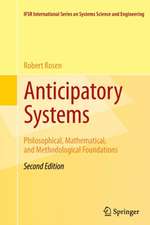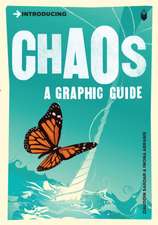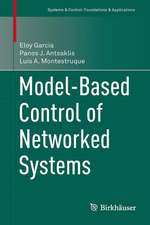Bifurcation and Chaos in Engineering
Autor Yushu Chen, Andrew Y.T. Leungen Limba Engleză Paperback – 5 dec 2011
Preț: 648.74 lei
Preț vechi: 763.22 lei
-15% Nou
Puncte Express: 973
Preț estimativ în valută:
124.18€ • 134.93$ • 104.37£
124.18€ • 134.93$ • 104.37£
Carte tipărită la comandă
Livrare economică 22 aprilie-06 mai
Preluare comenzi: 021 569.72.76
Specificații
ISBN-13: 9781447115779
ISBN-10: 1447115775
Pagini: 468
Ilustrații: XII, 452 p.
Dimensiuni: 155 x 235 x 25 mm
Greutate: 0.65 kg
Ediția:Softcover reprint of the original 1st ed. 1998
Editura: SPRINGER LONDON
Colecția Springer
Locul publicării:London, United Kingdom
ISBN-10: 1447115775
Pagini: 468
Ilustrații: XII, 452 p.
Dimensiuni: 155 x 235 x 25 mm
Greutate: 0.65 kg
Ediția:Softcover reprint of the original 1st ed. 1998
Editura: SPRINGER LONDON
Colecția Springer
Locul publicării:London, United Kingdom
Public țintă
ResearchCuprins
1 Dynamical Systems, Ordinary Differential Equations and Stability of Motion.- 1.1 Concepts of Dynamical Systems.- 1.2 Ordinary Differential Equations.- 1.3 Properties of Flow.- 1.4 Limit Point Sets.- 1.5 Liapunov Stability of Motion.- 1.6 Poincaré-Bendixson Theorem and its Applications.- 2 Calculation of Flows.- 2.1 Divergence of Flows 3.- 2.2 Linear Autonomous Systems and Linear Flows and the Calculation of Flows about the IVP.- 2.3 Hyperbolic Operator (or Generality).- 2.4 Non-linear Differential Equations and the Calculation of their Flows.- 2.5 Stable Manifold Theorem.- 3 Discrete Dynamical Systems.- 3.1 Discrete Dynamical Systems and Linear Maps.- 3.2 Non-linear Maps and the Stable Manifold Theorem.- 3.3 Classification of Generic Systems.- 3.4 Stability of Maps and Poincaré Mapping.- 3.5 Structural Stability Theorem.- 4 Liapunov—Schmidt Reduction.- 4.1 Basic Concepts of Bifurcation.- 4.2 Classification of Bifurcations of Planar Vector Fields.- 4.3 The Implicit Function Theorem.- 4.4 Liapunov—Schmidt Reduction.- 4.5 Methods of Singularity.- 4.6 Simple Bifurcations.- 4.7 Bifurcation Solution of the 1/2 Subharmonic Resonance Case of Non-linear Parametrically Excited Vibration Systems.- 4.8 Hopf Bifurcation Analyzed by Liapunov—Schmidt Reduction.- 5 Centre Manifold Theorem and Normal Form of Vector Fields.- 5.1 Centre Manifold Theorem.- 5.2 Saddle—Node Bifurcation.- 5.3 Normal Form of Vector Fields.- 6 Hopf Bifurcation.- 6.1 Hopf Bifurcation Theorem.- 6.2 Complex Normal Form of the Hopf Bifurcation.- 6.3 Normal Form of the Hopf Bifurcation in Real Numbers.- 6.4 Hopf Bifurcation with Parameters.- 6.5 Calculating Formula for the Hopf Bifurcation Solution.- 6.6 Stability of the Hopf Bifurcation Solution.- 6.7 Effective Method for Computing the Hopf BifurcationSolution Coefficients.- 6.8 Bifurcation Problem Involving Double Zero Eigenvalues.- 7 Application of the Averaging Method in Bifurcation Theory.- 7.1 Standard Equation.- 7.2 Averaging Method and Poincaré Maps.- 7.3 The Geometric Description of the Averaging Method.- 7.4 An Example of the Averaging Method — the Duffing Equation.- 7.5 The Averaging Method and Local Bifurcation.- 7.6 The Averaging Method, Hamiltonian Systems and Global Behaviour.- 8 Brief Introduction to Chaos.- 8.1 What is Chaos?.- 8.2 Some Examples of Chaos.- 8.3 A Brief Introduction to the Analytical Method of Chaotic Study.- 8.4 The Hamiltonian System.- 8.5 Some Statistical Characteristics.- 8.6 Conclusions.- 9 Construction of Chaotic Regions.- 9.1 Incremental Harmonic Balance Method (IHB Method).- 9.2 The Newtonian Algorithm.- 9.3 Number of Harmonic Terms.- 9.4 Stability Characteristics.- 9.5 Transition Sets in Physical Parametric Space.- 9.6 Example of the Duffing Equation with Multi—Harmonic Excitation.- 10 Computational Methods.- 10.1 Normal Form Theory.- 10.2 Symplectic Integration and Geometric Non-Linear Finite Element Method.- 10.3 Construction of the Invariant Torus.- 11 Non-linear Structural Dynamics.- 11.1 Bifurcations in Solid Mechanics.- 11.2 Non-Linear Dynamics of an Unbalanced Rotating Shaft.- 11.3 Galloping Vibration Analysis for an Elastic Structure.- 11.4 Other Applications of Bifurcation Theory.- References.
Caracteristici
Concentrates on the reduction of the number of unknowns, whereas deal only with a few unknowns Applied very much to real, practical engineering problems rather than merely theory Has an accessible, systematic approach and clear presentation













